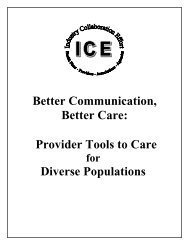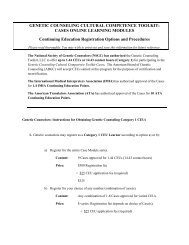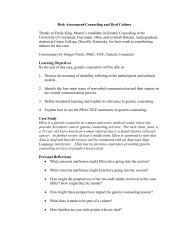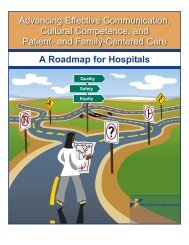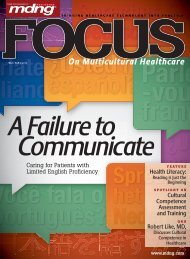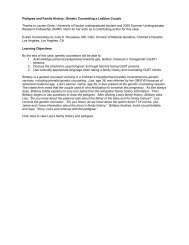making the business case for culturally and linguistically appropriate ...
making the business case for culturally and linguistically appropriate ...
making the business case for culturally and linguistically appropriate ...
Create successful ePaper yourself
Turn your PDF publications into a flip-book with our unique Google optimized e-Paper software.
PREFACEToday <strong>the</strong>re are more than 300 languages that are spoken in <strong>the</strong> United States. The changingdemographics of <strong>the</strong> country as well as federal <strong>and</strong> state policies have increased <strong>the</strong> need <strong>for</strong>effective <strong>and</strong> efficient <strong>business</strong> models that address <strong>culturally</strong> <strong>and</strong> <strong>linguistically</strong> <strong>appropriate</strong>health services <strong>for</strong> individuals with limited English proficiency (LEP). In 2000, based onTitle VI of <strong>the</strong> Civil Rights Act, <strong>and</strong> Presidential Executive Order 13166 1 , <strong>the</strong> Office ofMinority Health (OMH) published <strong>the</strong> National St<strong>and</strong>ards <strong>for</strong> Culturally <strong>and</strong> LinguisticallyAppropriate Services (CLAS) in Health Care. These st<strong>and</strong>ards have become <strong>the</strong> clearest,most thorough statement of policy regarding CLAS <strong>and</strong> <strong>the</strong>y guide health care organizationsin addressing <strong>the</strong> cultural <strong>and</strong> language needs of <strong>the</strong> patients <strong>the</strong>y serve. In addition to <strong>the</strong>serecommended service st<strong>and</strong>ards, <strong>the</strong>re are intuitively clear quality <strong>and</strong> efficiency reasons toassure an environment of <strong>culturally</strong> competent health care that can ultimately contribute to<strong>the</strong> reduction of racial <strong>and</strong> ethnic disparities in <strong>the</strong> health of people living in <strong>the</strong> UnitedStates.Although <strong>the</strong>re is a moral imperative <strong>and</strong> a framework of legal <strong>and</strong> regulatory requirements<strong>for</strong> addressing <strong>the</strong> cultural <strong>and</strong> linguistic needs of LEP patients, health care organizations areat different stages of familiarity <strong>and</strong> com<strong>for</strong>t with cultural competency in <strong>the</strong>ir work, <strong>and</strong>many health care organizations are new to <strong>the</strong> notion of developing programs to address<strong>the</strong>se equity issues. A number of obstacles need to be overcome be<strong>for</strong>e health careorganizations can develop <strong>and</strong> operationalize approaches to address <strong>the</strong> linguistic <strong>and</strong>cultural needs of <strong>the</strong>ir LEP patients. One of <strong>the</strong> most frequently cited impediments toprogress is <strong>the</strong> reluctance to implement projects that often come with developmental <strong>and</strong>operational costs, while also having an uncertain <strong>business</strong> benefit <strong>for</strong> <strong>the</strong> implementingorganization. Of course, many health care organizations have a rich history of meeting <strong>the</strong>cultural <strong>and</strong> linguistic needs of diverse patient populations. However, <strong>the</strong> lack of evenmodest in<strong>for</strong>mation about <strong>the</strong> <strong>business</strong> benefits that have been achieved by health careorganizations implementing CLAS-related projects has made it difficult <strong>for</strong> health careorganizations that are new to <strong>the</strong>se issues to push through this barrier to <strong>culturally</strong> competentcare.The Alliance of Community Health Plans Foundation, with funding from <strong>the</strong> MerckCompany Foundation, developed 13 individual <strong>case</strong> studies <strong>and</strong> a final report about <strong>the</strong>“<strong>business</strong> <strong>case</strong>” <strong>for</strong> projects that address one or more of <strong>the</strong> National CLAS St<strong>and</strong>ards. Thisreport provides some much needed in<strong>for</strong>mation about <strong>business</strong> benefits that have beenachieved by different types of health care organizations that have addressed one or moreaspects of <strong>the</strong> cultural <strong>and</strong> linguistic needs of patients. Clearly, <strong>the</strong>re are many creative costsaving<strong>and</strong> cost-avoiding approaches to cultural competence that have been quite successful.We at OMH are pleased to see this in<strong>for</strong>mation made available, <strong>and</strong> we hope it will be usefulto health care organizations that are struggling to develop <strong>and</strong> implement projects thataddress <strong>the</strong> CLAS St<strong>and</strong>ards.Guadalupe PachecoOffice of Minority HealthU.S. Department of Health <strong>and</strong> Human Services1 Civil Rights Forum, Volume 14, Number 3; http://www.usdoj.gov/crt/cor/Pubs/<strong>for</strong>um/00fall.htm4


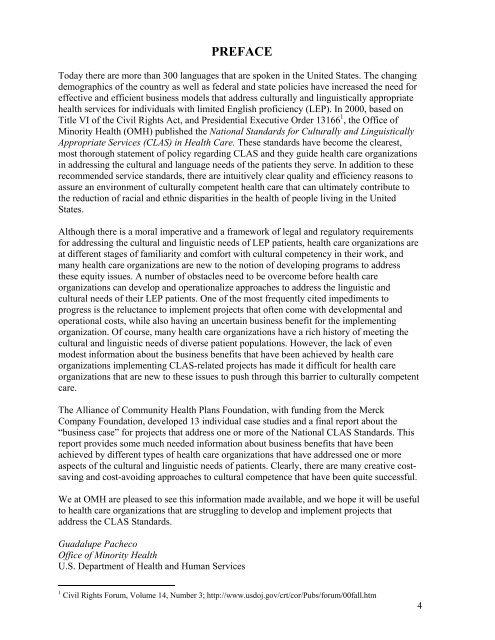
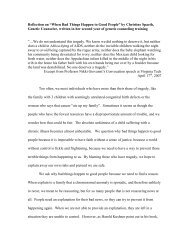
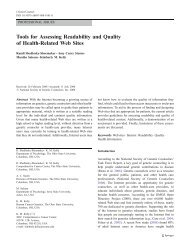

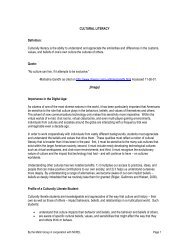
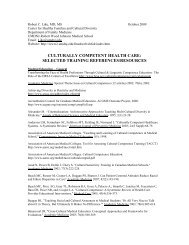

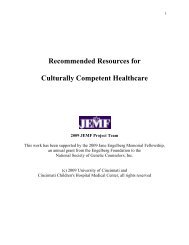
![Breaking Bad News PPT[1] - Genetic Counseling Cultural ...](https://img.yumpu.com/35003134/1/190x146/breaking-bad-news-ppt1-genetic-counseling-cultural-.jpg?quality=85)
